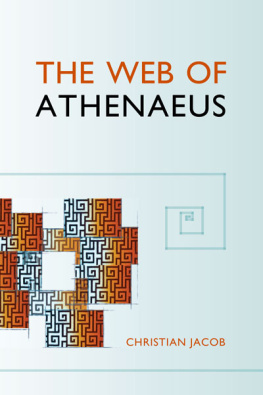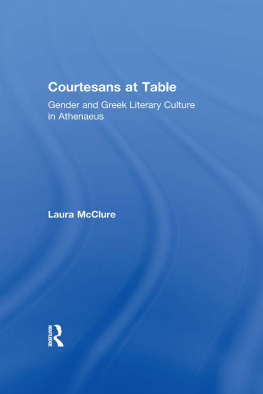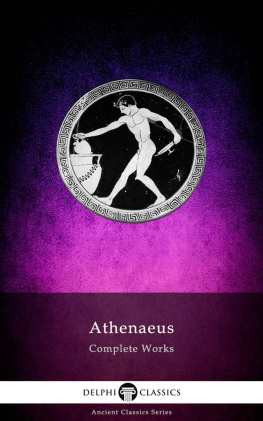Foreword
Why should anyone bother reading Athenaeus today? Among the extant corpus of Greek texts, the Deipnosophists is a paradoxical work, such a long and undigested text, with a confusing structure, a text mainly composed of fragments of other texts, of quotations from a lost a library. Athenaeus, like some other polymaths, scholiasts, or lexicographers, is one of those archivists and transmitters of ancient scholarship, providing contemporary readers with an inexhaustible quarry of data, information, words, citations, curiosa and various antiquarian oddities. This quarry is an inevitable starting point for anyone willing to edit the extant fragments of lost works (for example, the poets of Middle Comedy or the Greek historians) or for ballasting the footnotes of modern scholarly texts with thousand of references, pertaining to the widest range of topics one could imagine.
So why should anyone bother reading Athenaeus today, that is, considering his work as a coherent text, as the result from a meaningful project, as related to specific intellectual and literate interests and techniques, as a literary composition worthy of being read?
The shift from using Athenaeus as a mine of pithy references to reading his text in its continuity and architecture provides us with a different standpoint and opens many new perspectives. Instead of focusing on some tiny islands, such as a word, an object or a quotation, one has to take in account a wider horizon. One has to face the width, the extent of an ocean. The 15 books of the Deipnosophists are indeed a textual, a scholarly, an antiquarian ocean, and the reader feels disorientated, lost, and puzzled by such a vast and unknown space whose mapping and survey seem out of reach. Trying to understand the reasons of such a disorientation, trying to set up stable landmarks in this textual flood, shedding light on the underlying structure, such would be the only ways for our reader to navigate safely through this text, from the beginning of Book One to the end of Book Fifteen. The purpose of this book is to provide the reader with a map and a compass before he or she enters the world of Athenaeus.
My periplous through Athenaeus started in 1996, when I answered a call for papers launched by David Braund and John Wilkins, organizers of the Exeter conference on Athenaeus (1997). I proposed a paper about bibliographical knowledge in the Deipnosophists, about Athenaeus as a librarian. A first survey of Athenaeus text put made me aware of the many links with Alexandrian scholarship and with the history of ancient libraries. Athenaeus and his characters were interested not only in texts and words, but also in books, in their form, in their identification, in their collection.
Athenaeus opened new and unexpected perspectives in my ongoing reflection on ancient libraries, on the Museum of Alexandria and its scholars. My first impression was that the Deipnosophists allowed us to observe ancient readers at work and at play. For documenting this hypothesis, I followed a double method. First, I started a full reading of the Deipnosophists, from beginning to end, creating an index linking together key words, personal comments, Greek text, and translation. It seemed appropriate and to a certain extent ironic to apply to Athenaeus text his own method of excerpting, to submit his text to the grid of an intensive and close reading, even when he seemed more interested in expansive reading crossing hundreds of books. Second, I started systematic searches through the Thesaurus Linguae Graecae database, in order to gather all the occurrences and the context of keywords such as biblion, grapsai, pinax, anagignskein, etc.
The Exeter Conference proceedings were published in 2000. The book Athenaeus and His World, Reading Greek Culture in the Roman World (David Braund and John Wilkins ed., Exeter: University of Exeter Press) was a groundbreaking landmark among studies of Athenaeus and it shed a new light on the text and its context, on the author and his methods, on his library and the ways he used it. This collective endeavor allowed different disciplinary approaches to map the interests of Athenaeus, his use of sources, his connection to learned traditions, either philosophical, medical, grammatical or historiographical.
By that time, I was involved in a new project, far more ambitious. Luciano Canfora invited me to join a team of Italian scholars, coordinated by Leo Citelli and Maria Luisa Gambato, who were working on an annotated translation of the Deipnosophists. This new translation was published in 2001, as a set of four luxurious volumes, Ateneo, IDeipnosofisti, I Dotti a Banchetto (Rome: Salerno Editrice). I was asked to write the general introduction to these volumes.
Athenaeus and His World was a collective endeavor, bringing together specialists in all the different topics and literary genres Athenaeus was interested in. The purpose of the Exeter conference and volume was to map the terra incognita of the Deipnosophists, through a thematic coverage, a large scale survey. My essay Ateneo o il Dedalo delle Parole (Athenaeus, or the Labyrinth of Words) tried to draw a small-scale map of the Deipnosophists, that is, to face general questions about the nature and the meaning of this text, and the intentions of its author.
The Web of Athenaeus is the English revised version of Ateneo o il Dedalo delle Parole. My goal is to offer a general introduction to the Deipnosophists but also a strong reading hypothesis: beyond the heterogeneous surface of the text, beyond the excesses, the fun, the parody, and the comedy, there is a project, an intent, a scholarly base. Athenaeus himself remains a mysterious author, and we have no biographical information beyond the very few pieces he reveals about himself. His monumental work remains an enigma too. Was it intended for public circulation? For which readers? Was it a tribute to Larensius, the Roman patron of the deipnosophists? Or should we consider that the fifteen books put together by Athenaeus were devoted to his own personal use? We have very little evidence about ancient use of the Deipnosophists, but the text survived its author and was known at least, perhaps already in an epitomized form, by Macrobius, Stephanus Byzantinus, Constantinus Porphyrogenitus, the Suda, and Eusthatius.
My point in this essay is to understand Athenaeus intellectual project and also the literary frame he chose, that is, banquet-conversation. It is indeed a traditional genre, already exemplified by Plato, Xenophon, Plutarch, and Petronius. The question is: did Athenaeus use this frame as a mere literary fiction, in order to rearrange hundreds of reading notes, words, and excerpts? Or does the dialogue of Larensius guests mirror something else, some scholarly and literate interactions in a learned salon at the beginning of the 3rd century AD?
I tried to go deeply into this hypothesis. That is, I consider one should take seriously the characters staged in this banquet, their interactions, the dynamics of their dialogue, the way they comment on their conversation and on their knowledge. As with the AtticNights of Aulus Gellius, Plutarchs Sumposiaca, the recently discovered treatise of Galen, PeriAlupias (On the Absence of Grief), I consider the Deipnosophists a field for an anthropologist of ancient knowledge and scholarship. Through this text, its narrative set-up, the dynamics of interaction, and its uninterrupted flow of words, quotations, comments, questions, and answers, one can observe the behavior, the mental mechanisms, the cultural concerns, the scholarly techniques of a group of ancient philosophers, grammarians, jurists, musicians, and physicians at play. The dinner and the symposion were the place of a codified social ritual, they were also a frame for scholarly and intellectual activities, as the Aristotelian school and the Museum of Alexandria testify.









